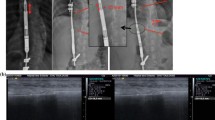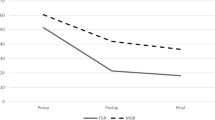Abstract
Scoliosis needs surgical correction when the spinal curve surpasses 45 or 50 degrees, especially after skeletal maturity, particularly if it causes loss of lung function. Typically, a posterior fusion has been a standard treatment for scoliosis, and orthopaedic surgeons will use segmental pedicle screw constructs with hooks and wires.
Anterior approaches had been performed for thoracolumbar and lumbar scoliosis with thoracoscopic and/or laparoscopic-assisted techniques using anterior instrumentation for the thoracic curve employing video-assisted thoracoscopic surgery techniques but faded out for more fashionable posterior approaches. Selected severe idiopathic scoliosis cases may need manifold vertebral wedge osteotomies without fusion. This chapter will review the literature published on magnetically controlled growing rod (MCGR) to decrease the complications related to frequent surgical rod lengthenings and diminish numerous surgeries that follow.
Access this chapter
Tax calculation will be finalised at checkout
Purchases are for personal use only
Similar content being viewed by others
References
Akbarnia BA, Mundis GM Jr, Salari P, Yaszay B, Pawelek JB. Innovation in growing rod technique: a study of safety and efficacy of a magnetically controlled growing rod in a porcine model. Spine (Phila Pa 1976). 2012;37(13):1109–14.
Cheung KM, Cheung JP, Samartzis D, et al. Magnetically controlled growing rods for severe spinal curvature in young children: a prospective case series. Lancet. 2012;379(9830):1967–74.
Hickey BA, Towriss C, Baxter G, et al. Early experience of MAGEC magnetic growing rods in the treatment of early onset scoliosis. Eur Spine J. 2014;23(Suppl 1):S61–5.
Jenks M, Craig J, Higgins J, et al. The MAGEC system for spinal lengthening in children with scoliosis: a NICE medical technology guidance. Appl Health Econ Health Policy. 2014;12(6):587–99.
Rolton D, Richards J, Nnadi C. Magnetic controlled growth rods versus conventional growing rod systems in the treatment of early onset scoliosis: a cost comparison. Eur Spine J. 2015;24(7):1457–61.
Stokes OM, O’Donovan EJ, Samartzis D, Bow CH, Luk KD, Cheung KM. Reducing radiation exposure in early-onset scoliosis surgery patients: novel use of ultrasonography to measure lengthening in magnetically-controlled growing rods. Spine J. 2014;14(10):2397–404.
Cheung JP, Cahill P, Yaszay B, Akbarnia BA, Cheung KM. Special article: update on the magnetically controlled growing rod: tips and pitfalls. J Orthop Surg (Hong Kong). 2015;23(3):383–90.
Cheung JPY, Yiu KKL, Samartzis D, Kwan K, Tan BB, Cheung KMC. Rod lengthening with the magnetically controlled growing rod: factors influencing rod slippage and reduced gains during distractions. Spine (Phila Pa 1976). 2018;43(7):E399–405.
Lorenz HM, Badwan B, Hecker MM, et al. Magnetically controlled devices parallel to the spine in children with spinal muscular atrophy. JB JS Open Access. 2017;2(4):e0036. Published 2017 Nov 28.
Joyce TJ, Smith SL, Rushton PRP, Bowey AJ, Gibson MJ. Analysis of explanted magnetically controlled growing rods from seven UK spinal centers. Spine (Phila Pa 1976). 2018;43(1):E16–22.
Gilday SE, Schwartz MS, Bylski-Austrow DI, et al. Observed length increases of magnetically controlled growing rods are lower than programmed. J Pediatr Orthop. 2018;38(3):e133–7.
Thakar C, Kieser DC, Mardare M, Haleem S, Fairbank J, Nnadi C. Systematic review of the complications associated with magnetically controlled growing rods for the treatment of early onset scoliosis. Eur Spine J. 2018;27(9):2062–71.
Poon S, Spencer HT, Fayssoux RS, Sever R, Cho RH. Maximal force generated by magnetically controlled growing rods decreases with rod lengthening. Spine Deform. 2018;6(6):787–90.
Subramanian T, Ahmad A, Mardare DM, Kieser DC, Mayers D, Nnadi C. A six-year observational study of 31 children with early-onset scoliosis treated using magnetically controlled growing rods with a minimum follow-up of two years. Bone Joint J. 2018;100-B(9):1187–200.
Hung CW, Vitale MG, Samdani A, et al. Outcomes of primary and conversion magnetically controlled growth rods are different at two-year follow-up: results of North American release. Spine Deform. 2019;7(5):829–35.
Luhmann SJ, McAughey EM, Ackerman SJ, Bumpass DB, McCarthy RE. Cost analysis of a growth guidance system compared with traditional and magnetically controlled growing rods for early-onset scoliosis: A US-based integrated health care delivery system perspective. Clinicoecon Outcomes Res. 2018;10:179–87. Published 2018 Mar 16.
Pepke W, Almansour H, Diebo BG, Akbar M. Correction of the spine with magnetically controlled growing rods in early onset scoliosis: A pre-to-post analysis of 21 patients with 1-year follow-up [published online ahead of print, 2019 Sep 10]. Korrektur der Wirbelsäule mit magnetisch kontrollierten mitwachsenden Stäben bei Patienten mit Early-onset-Skoliose : Prä-Post-Analyse von 21 Patienten mit 1-Jahres-Follow-up [published online ahead of print, 2019 Sep 10]. Orthopade. 2019; https://doi.org/10.1007/s00132-019-03801-x.
Oetgen ME, McNulty EM, Matthews AL. Cost-effectiveness of magnetically controlled growing rods: who really benefits? Spine Deform. 2019;7(3):501–4.
Harshavardhana NS, Noordeen MHH, Dormans JP. Cost analysis of magnet-driven growing rods for early-onset scoliosis at 5 years. Spine (Phila Pa 1976). 2019;44(1):60–7.
Rushton PRP, Smith SL, Forbes L, Bowey AJ, Gibson MJ, Joyce TJ. Force testing of explanted magnetically controlled growing rods. Spine (Phila Pa 1976). 2019;44(4):233–9.
Roye BD, Marciano G, Matsumoto H, et al. Is rod diameter associated with the rate of rod fracture in patients treated with magnetically controlled growing rods? [published online ahead of print, 2020 Jun 19]. Spine Deform. 2020; https://doi.org/10.1007/s43390-020-00161-x.
Doany ME, Olgun ZD, Kinikli GI, et al. Health-related quality of life in early-onset scoliosis patients treated surgically: EOSQ scores in traditional growing rod versus magnetically controlled growing rods. Spine (Phila Pa 1976). 2018;43(2):148–53.
Panagiotopoulou VC, Tucker SK, Whittaker RK, et al. Analysing a mechanism of failure in retrieved magnetically controlled spinal rods. Eur Spine J. 2017;26(6):1699–710.
Cheung JPY, Yiu K, Kwan K, Cheung KMC. Mean 6-year follow-up of magnetically controlled growing rod patients with early onset scoliosis: a glimpse of what happens to graduates. Neurosurgery. 2019;84(5):1112–23.
Lebon J, Batailler C, Wargny M, et al. Magnetically controlled growing rod in early onset scoliosis: a 30-case multicenter study. Eur Spine J. 2017;26(6):1567–76.
Yoon WW, Chang AC, Tyler P, Butt S, Raniga S, Noordeen H. The use of ultrasound in comparison to radiography in magnetically controlled growth rod lengthening measurement: a prospective study. Eur Spine J. 2015;24(7):1422–6.
Choi E, Yaszay B, Mundis G, et al. Implant complications after magnetically controlled growing rods for early onset scoliosis: a multicenter retrospective review. J Pediatr Orthop. 2017;37(8):e588–92.
Cheung JPY, Cheung PWH, Cheung KMC. The effect of magnetically controlled growing rods on three-dimensional changes in deformity correction. Spine Deform. 2020;8(3):537–46. https://doi.org/10.1007/s43390-020-00055-y.
Guan D, Zhang Y, Xu J. Clinical outcome of magnetically controlled growing rod in early-onset scoliosis: a systematic review. Clin Spine Surg. 2020;33(4):150–5.
Author information
Authors and Affiliations
Editor information
Editors and Affiliations
Rights and permissions
Copyright information
© 2021 Springer Nature Switzerland AG
About this chapter
Cite this chapter
Gagner, M. (2021). Use of Magnetically Controlled Growing Rod Implants for the Spine. In: Gagner, M. (eds) Magnetic Surgery. Springer, Cham. https://doi.org/10.1007/978-3-030-73947-8_17
Download citation
DOI: https://doi.org/10.1007/978-3-030-73947-8_17
Published:
Publisher Name: Springer, Cham
Print ISBN: 978-3-030-73946-1
Online ISBN: 978-3-030-73947-8
eBook Packages: MedicineMedicine (R0)




